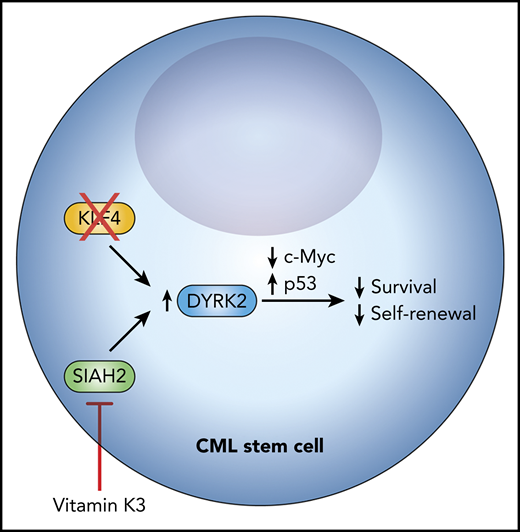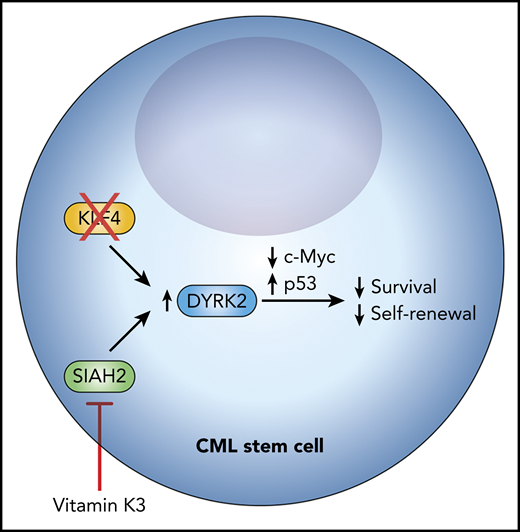In this issue of Blood, Park et al describe a novel KLF4-DYRK2–mediated pathway that affects survival and self-renewal of leukemic stem cells (LSCs) in chronic myeloid leukemia (CML).1
Schematic of the vitamin K3-SIAH2–mediated stabilization of DYRK2 leading to decreased survival and self-renewal of CML LSCs via depletion of c-Myc and activation of p53.
Schematic of the vitamin K3-SIAH2–mediated stabilization of DYRK2 leading to decreased survival and self-renewal of CML LSCs via depletion of c-Myc and activation of p53.
In ancient Greek mythology, the minotaur, a curious and ferocious creature with the head and tail of a bull and the body of a man, dwelt in a maze on the Greek island of Crete, constructed by the architect Daedalus. The labyrinth shielded the minotaur, who sustained himself by devouring young men and women before being slaughtered by the hero Theseus.
The LSC, by analogy, has evolved an ever-growing maze of signal transduction pathways leading to LSC survival, self-renewal and, consequently, therapy resistance. Eradication of the LSC is the goal of many researchers working in this field, although this concept may be controversial, at least in CML.2,3 Novel complexities and intricate connections between pathways have been discovered in this labyrinth, yet, as the ancient Greeks would say, the song of the single hero killing the minotaur has not yet been sung.
The remarkable efficacy of tyrosine kinase inhibitors (TKIs) in controlling CML and inducing deep molecular remissions have now led clinicians, scientists, and patients to the question of whether treatment may safely be stopped. However, studies have shown that only around 40% of patients maintain a complete molecular remission after withdrawal of TKI therapy,4 maintaining a so called “treatment-free remission.” The remaining 60% of patients relapse. Factors influencing the risk of recurrence may include immune surveillance of the CML stem cell clone, efficient sheltering of the CML stem cell by the bone marrow microenvironment or other protective niches, or CML stem cell–intrinsic signal transduction pathways.
Several pathways, including p53,5 c-MYC, and many others, mediate the survival of CML LSCs and their resistance to TKIs. CML LSCs are independent of the oncoprotein BCR-ABL1, which causes the disease. Stabilization of p53 and downregulation of c-Myc, but not BCR-ABL1 itself, has been shown to lead to efficient elimination of CML LSCs, while not affecting normal hematopoietic stem cells.5 Follow-up studies have shed light on other pathways and strategies for increasing levels of p53 to efficiently eradicate LSCs in CML.6,7 Indeed, p53-activating agents may be an effective way of inducing cure in CML patients.8
In the article by Park et al, the authors reveal a novel pathway that leads to decreased survival and self-renewal in CML via activation of p53 and depletion of c-Myc. They show that loss of the zinc-finger transcription factor Krüppel-like factor 4 (KLF4) derepresses and, consequently, increases the protein kinase DYRK2. This stabilization of dual-specificity tyrosine-(Y)-phosphorylation-regulated kinase 2 (DYRK2) in turn depletes CML LSCs via decreasing c-Myc and increasing p53 (see figure). The authors demonstrate that deficiency of Klf4 in BCR-ABL1+ LSCs in a murine transplantation model led to significant prolongation of survival of the recipient mice, suggesting that KLF4 is essential for maintenance of LSCs in CML. These findings support the concept that KLF4 promotes anti-apoptosis and self-renewal of CML LSCs, and they identify DYRK2 as a transcriptional target of KLF4 in CML LSCs. Elevated levels of DYRK2, as observed in deficiency of KLF4, resulted in depletion of c-Myc and activation of p53. On the basis of the knowledge that the ubiquitin ligase SIAH2 mediates the degradation of DYRK2 by the proteasome and that menadione or vitamin K3 inhibit SIAH2, the authors achieved stable levels of DYRK2 by chemical means. In analogy to Klf4 deficiency, treatment with vitamin K3 led to apoptosis and abrogated self-renewal of murine and human CML LSCs by affecting c-Myc and p53 without overt toxicity.
In summary, the Park et al study sheds light on a novel and potentially targetable pathway that modulates levels of p53 and c-Myc, which had already been shown to maintain BCR-ABL1–independent LSCs in CML. Vitamin K3 had no deleterious effects on the frequency of phenotypic hematopoietic stem cells, although future studies will need to verify their functional status. This newly unraveled pathway offers a novel approach for eradication of the LSCs in CML. However, a combination of various strategies aimed at the modulation of the p53/c-Myc network in CML, as described,5 and as used in multimodal therapies directed at HIV may be a more successful path than the use of a single drug alone, because that would likely lead to resistance. It is hoped that the therapeutic vitamin K3-DYRK2 axis will become a legendary hero by slaying of the minotaur, just like Theseus.
Conflict-of-interest disclosure: The author declares no competing financial interests.



